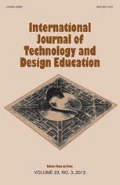Abstract
This article examines the effect of scientific detective video as a vehicle to support the design of technology activities by technology teachers. Ten graduate students, including current and future technology teachers, participated in a required technology graduate course that used scientific detective videos as a pedagogical tool to motivate their interest in science and technology and to reinforce creative competence in designing technology learning activities (TLAs). The participants watched three scientific detective videos and analyzed them for scientific principles and technologies. An analysis report and interview were conducted to collect participants’ understanding and application of scientific principles and technologies. The main findings were that (a) influencing teacher’s design of TLAs through scientific detective videos is feasible; (b) prior personal conditions and external factors influence teacher’s design of TLAs; and (c) the analysis of scientific detective videos helps teachers to design TLAs appropriately. This study demonstrated the broad utility of scientific detective videos for inspiring technology teachers to integrate science and technology in their activity design.









Similar content being viewed by others
References
Anderson, O. R. (1996). A neurocognitive perspective on current learning theory and science instructional strategies. Science Education, 81, 67–89.
Black, P., & Harrison, G. (1985). In place of confusion: Technology and science in the school curriculum. London: The Nuffield-Chelsea Curriculum Trust/The National Centre for School Technology, Trent Polytechnic.
Brake, M., & Thornton, R. (2003). Science fiction in the classroom. Physics Education, 38(1), 31–34.
Dubeck, L. W., Moshier, S. E., & Boss, J. E. (2004). Fantastic voyages: Learning science through science fiction films (2nd ed.). New York: Springer.
Efthimiou, C., & Llewellyn, R. A. (2004). Cinema as a tool for science literacy. Physics Education, 16(1), 1–13.
Fleer, M. (2000). Working technologically: Investigations into how young children design and make during technology education. International Journal of Technology and Design Education, 10(1), 43–59.
Hanson, D., Burton, D., & Guam, G. (2006). Six Concepts to help you align with NCLB. The Technology Teacher, 65(1), 17–20.
Ihde, D. (1997). The structure of technology knowledge. International Journal of Technology and Design Education, 7(1), 73–79.
Kimbell, R., Stables, K., & Green, R. (2002). The nature and purpose of design and technology. In G. Owen-Jackson (Ed.), Teaching design and technology in secondary schools (pp. 19–30). Landon: RoutledgeFalmer.
Labianca, D. A., & Reeves, W. J. (1981). Chemistry and detective fiction: An interdisciplinary program for the non-science major. Journal of Chemical Education, 58(9), 683–686.
Lewis, T. (2005). Creativity: A framework of the design/problem solving discourse in technology education. Journal of Technology Education, 17(1), 35–52.
McCormick, R. (2004). Issues of learning and knowledge in technology education. International Journal of Technology and Design Education, 14(1), 21–44.
Newmann, F. M., & Wehlage, G. G. (1993). Five standards of authentic instruction. Educational Leadership, 50(7), 8–12.
Sidawi, M. M. (2009). Teaching science through designing technology. International Journal of Technology and Design Education, 19(3), 269–287.
Author information
Authors and Affiliations
Corresponding author
Rights and permissions
About this article
Cite this article
Yu, KC., Fan, SC., Tsai, FH. et al. Using scientific detective videos to support the design of technology learning activities. Int J Technol Des Educ 23, 883–901 (2013). https://doi.org/10.1007/s10798-012-9225-5
Published:
Issue Date:
DOI: https://doi.org/10.1007/s10798-012-9225-5




